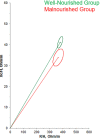Comparison of Bioelectrical Impedance Vector Analysis (BIVA) to 7-point Subjective Global Assessment for the diagnosis of malnutrition
- PMID: 34590669
- PMCID: PMC9269190
- DOI: 10.1590/2175-8239-JBN-2021-0099
Comparison of Bioelectrical Impedance Vector Analysis (BIVA) to 7-point Subjective Global Assessment for the diagnosis of malnutrition
Abstract
Introduction: Bioelectrical impedance vector analysis (BIVA) is a non-invasive and low-cost strategy. The methods used to assess malnutrition in patients undergoing HD are still a challenge. The aim of the present study was to compare BIVA to 7-Point Subjective Global Assessment (7-point SGA) to identify malnutrition. We also investigated the sensitivity and specificity of the previously proposed cutoffs point for BIVA parameters.
Methods: Patients of both sexes, over 20 years of age, on HD treatment were included. Anthropometric parameters, laboratory data, and bioelectrical impedance analysis (BIA) were evaluated. Values of resistance (R) and reactance (Xc) obtained by mono-frequency BIA were normalized to body height (H) to generate a graph of the bioimpedance vector with the BIVA software. The analysis of the area under the receiver operating curve ROC (AUC) was performed.
Results: Among the included 104 patients, the mean age was 51.70 (±15.10) years, and 52% were male. The BIVA had a sensitivity of 35% for diagnosing malnutrition. The specificity of BIVA for identifying the well-nourished patients was 85.7%. The diagnostic accuracy between the BIVA and 7-point SGA was AUC=0.604; 95%CI 0.490-0.726, higher than the previously established cutoff values (AUC=0.514; 95%CI: 0.369-0.631). The 95% confidence ellipses did not overlap (p<0.05).
Conclusion: Our study showed low accuracy of BIVA for diagnosing malnutrition using a 7-point SGA as a reference standard. However, it is a complementary method for assessing nutritional status as it provides data on cellularity and hydration, which are important aspects for the HD population.
Introdução:: Análise vetorial de impedância bioelétrica (BIVA) é uma estratégia não invasiva e de baixo custo. Os métodos usados para avaliar desnutrição em pacientes em HD ainda são um desafio. O objetivo do presente estudo foi comparar BIVA com Avaliação Subjetiva Global de 7 pontos (ASG de 7 pontos) para identificar desnutrição. Também investigamos sensibilidade e especificidade do ponto de corte proposto anteriormente para parâmetros de BIVA.
Métodos:: Foram incluídos pacientes de ambos os sexos, acima de 20 anos, em HD. Foram avaliados parâmetros antropométricos, dados laboratoriais e análise de impedância bioelétrica (BIA). Valores de resistência (R) e reatância (Xc) obtidos por BIA de mono-frequência foram normalizados para altura corporal (H) gerando um gráfico do vetor de bioimpedância com a ajuda do software BIVA. Foi realizada uma análise da área sob a curva ROC (AUC).
Resultados:: Entre 104 pacientes incluídos, a idade média foi 51,70 (±15,10) anos, e 52% eram homens. BIVA demonstrou sensibilidade de 35% para diagnosticar desnutrição. A especificidade da BIVA para identificar pacientes bem nutridos foi 85,7%. A precisão diagnóstica entre BIVA e ASG de 7 pontos foi AUC=0,604; IC95%: 0,490-0,726, superior aos valores de corte estabelecidos anteriormente (AUC=0,514; IC95%: 0,369-0,631). Elipses de confiança de 95% não se sobrepuseram (p<0,05).
Conclusão:: Nosso estudo mostrou baixa precisão da BIVA para diagnóstico de desnutrição usando ASG-7 pontos como padrão de referência. Entretanto, é um método complementar para avaliar estado nutricional, pois fornece dados sobre celularidade e hidratação, aspectos importantes para a população em HD.
Conflict of interest statement
The authors declare that they have no conflict of interest.
Figures


Comment in
-
Nutritional assessment in dialysis patients: Much more than body composition.J Bras Nefrol. 2022 Apr-Jun;44(2):143-144. doi: 10.1590/2175-8239-JBN-2021-0279. J Bras Nefrol. 2022. PMID: 35199823 Free PMC article. No abstract available.
References
-
- Cederholm T, Barazzoni R, Austin P, Ballmer P, Biolo G, Bischoff SC. ESPEN Guideline ESPEN guidelines on definitions and terminology of clinical nutrition. Clin Nutr. 2017;36(1):49–64. - PubMed
-
- Hanna RM, Ghobry L, Wassef O, Rhee CM, Kalantar-Zadeh K. A practical approach to nutrition, protein-energy wasting, sarcopenia, and cachexia in patients with chronic kidney disease. Blood Purif. 2020;49(2):202–211. - PubMed
-
- Martins VS, Aguiar L, Dias C, Lourenço P, Pinheiro T, Velez B. Predictors of nutritional and inflammation risk in hemodialysis patients. Clin Nutr. 2020 Jun;39(6):1878–1884. - PubMed
-
- Ikizler TA, Burrowes JD, Byham-Gray LD, Campbell KL, Carrero JJ, Chan W. KDOQI clinical practice guideline for nutrition in CKD: 2020 update. Am J Kidney Dis. 2020 Sep;76(3) Suppl 1:S1–S107. - PubMed
-
- Fouque D, Kalantar-Zadeh K, Kopple J, Cano N, Chauveau P, Cuppari L. A proposed nomenclature and diagnostic criteria for protein-energy wasting in acute and chronic kidney disease. Kidney Int. 2008 Feb;73(4):391–398. - PubMed
MeSH terms
LinkOut - more resources
Full Text Sources
Medical

